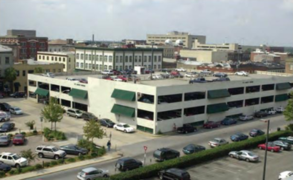 City Market in 2017, looking east from West St Julian Street to Ellis Square | |
 | |
| Location | Savannah, Georgia, United States |
|---|---|
| Coordinates | 32°04′51″N81°05′42″W / 32.0808290°N 81.0949980°W |
| Opening date | 1733 |
| Website | savannahcitymarket |
City Market is a historic market complex in the Historic District of Savannah, Georgia. Originally centered on the site of today's Ellis Square from 1733, [1] today it stretches west from Ellis Square to Franklin Square. [2] [3] Established in the 1700s with a wooden building, locals gathered here for their groceries and services. [1] This building burned in the Great Savannah Fire of 1820 and was replaced the following year with a single-storey structure that wrapped around the square. [4] "It was a wooden shed, about twenty-five feet wide," remembered historian Charles Seton Henry Hardee, who moved to Savannah in 1835. It had a shingle roof, supported by brick pillars. An uncovered section was used for the sale of live poultry and seafood. The covered area was mainly used for the sale of vegetables and dressed poultry. [5] A brick building, the work of architects Augustus Schwaab and Martin Phillip Muller, was erected in 1876. [4] They had submitted plans to the city six years earlier. The cost of the building's construction "vastly exceeded expectations" after excavations revealed weakened arches in the basement floor that required them to be replaced. [6] It was an ornate structure with arches in the Romanesque style and large circular windows. [7]
Contents
- Ellis Square parking garage controversy
- Timeline of market buildings
- Buildings in City Market
- Gallery
- References
- Bibliography
The interior of the Schwaab and Muller structure encompassed 33,000 square feet. The city's mayor, John Screven, described it as "roomy, capable of being kept in the highest condition of cleanliness, with ample ventilation". The construction was headed by carpenter James C. Saltus. [8]
The market area survived two fires (in 1796 and 1820), [9] [10] the Civil War, and the hurricane of 1896. [2] It is now part of the Savannah Historic District, and is a popular destination for tourists due to its restaurants, art galleries and shops, which occupy many of the buildings erected in the 19th century. [2]
Sweet Georgia Brown's, a piano bar which gained popularity after its appearance in John Berendt's 1994 book Midnight in the Garden of Good and Evil , was located at 312 West St. Julian Street.








